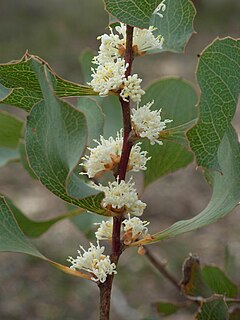Erringibba is a national park at Glenmorgan in the far west of the Darling Downs region of southern Queensland, Australia, 329 km west of Brisbane. The park was established in 1999 and covers 8.77 km2 (3.39 sq mi). The park lies within the catchment area of the Condamine River and the Brigalow Belt South bioregion.

The blue jay is a passerine bird in the family Corvidae, native to eastern North America. It lives in most of the eastern and central United States; some eastern populations may be migratory. Resident populations are also in Newfoundland, Canada; breeding populations are found across southern Canada. It breeds in both deciduous and coniferous forests, and is common in residential areas. Its coloration is predominantly blue, with a white chest and underparts, and a blue crest; it has a black, U-shaped collar around its neck and a black border behind the crest. Males and females are similar in size and plumage, and plumage does not vary throughout the year. Four subspecies have been recognized.

The hooded seal is a large phocid found only in the central and western North Atlantic, ranging from Svalbard in the east to the Gulf of St. Lawrence in the west. The seals are typically silver-grey or white in color, with black spots that vary in size covering most of the body. Hooded seal pups are known as "blue-backs" because their coats are blue-grey on the back with whitish bellies, though this coat is shed after 14 months of age when the pups molt.

Celosia is a small genus of edible and ornamental plants in the amaranth family, Amaranthaceae. The generic name is derived from the Ancient Greek word κήλεος, meaning "burning", and refers to the flame-like flower heads. Species are commonly known as woolflowers, or, if the flower heads are crested by fasciation, cockscombs. The plants are well known in East Africa's highlands and are used under their Swahili name, mfungu.

Celosia argentea, commonly known as the plumed cockscomb or silver cock's comb, is a herbaceous plant of tropical origin, and is known for its very bright colors. In India and China it is known as a troublesome weed.

The crested porcupine, also known as the African crested porcupine, is a species of rodent in the family Hystricidae native to Italy, North Africa and sub-Saharan Africa.

The crested servaline genet, also known as the crested genet, is a genet species endemic to Nigeria and Cameroon. As the population has declined due to loss of habitat, it is listed as Vulnerable on the IUCN Red List. It was first recorded in the Mamfe Division in Cameroon and initially considered a subspecies of the servaline genet. But now it is regarded as a distinct species.

Dryopteris cristata is a species of fern native to wetlands throughout the Northern Hemisphere. It is known as crested wood fern or crested buckler-fern. This plant is a tetraploid species of hybrid origin, one parent being Dryopteris ludoviciana and the other being the unknown, apparently extinct species, dubbed Dryopteris semicristata, which is also one of the presumed parents of Dryopteris carthusiana. D. cristata in turn is one of the parents of Dryopteris clintoniana, another fern of hybrid origin.

Hakea cristata, commonly known as the snail hakea, is a shrub in the family Proteaceae native to Western Australia. An ornamental prickly shrub with attractive foliage and creamy white rounded flowers appearing in profusion in the winter months.

Lepiota cristata, commonly known as the stinking dapperling or the stinking parasol, is an agaric and possibly poisonous mushroom in the family Agaricaceae. A common and widespread species—one of the most widespread fungi in the genus Lepiota—it has been reported from Europe, northern Asia, North America, and New Zealand. It fruits on the ground in disturbed areas, such as lawns, path and road edges, parks, and gardens. The species produces fruit bodies characterized by the flat, reddish-brown concentric scales on the caps, and an unpleasant odour resembling burnt rubber. Similar Lepiota species can sometimes be distinguished from L. cristata by differences in cap colour, stipe structure, or odour, although some species can only be reliably distinguished through the use of microscopy.

Mesosini is a tribe of longhorn beetles of the subfamily Lamiinae.

Agelasta is a genus of longhorn beetles of the subfamily Lamiinae.
Agelasta nigrolineata is a species of beetle in the family Cerambycidae. It was described by Stephan von Breuning in 1968. It is known from Laos.
Agelasta birmanica is a species of beetle in the family Cerambycidae. It was described by Stephan von Breuning in 1935. It is known from Myanmar, Laos, Vietnam, and Thailand.
Agelasta catenata is a species of beetle in the family Cerambycidae. It was described by Francis Polkinghorne Pascoe in 1862. It is known from Malaysia, Cambodia, Laos, Borneo and Vietnam. It contains the varietas Agelasta catenata var. infasciata.
Agelasta perplexa is a species of beetle in the family Cerambycidae. It was described by Francis Polkinghorne Pascoe in 1858. It is known from China, Taiwan and Japan.
Agelasta tonkinea is a species of beetle in the family Cerambycidae. It was described by Pic in 1925.
Agelasta konoi is a species of beetle in the family Cerambycidae. It was described by Masao Hayashi in 1956.
Agelasta yonaguni is a species of beetle in the family Cerambycidae. It was described by Masao Hayashi in 1962. It is known from Japan.
Agelasta newmanni is a species of beetle in the family Cerambycidae. It was described by White in 1856. It is known from Borneo and Malaysia.










